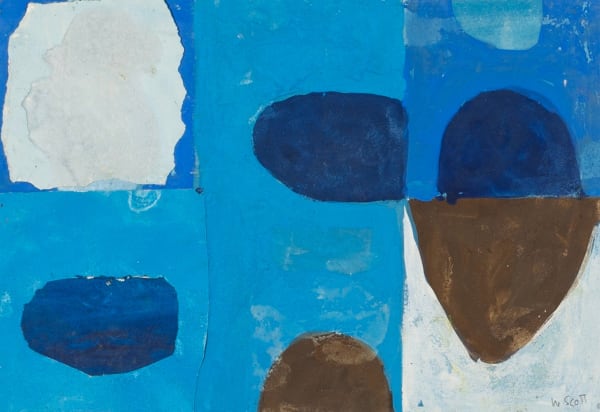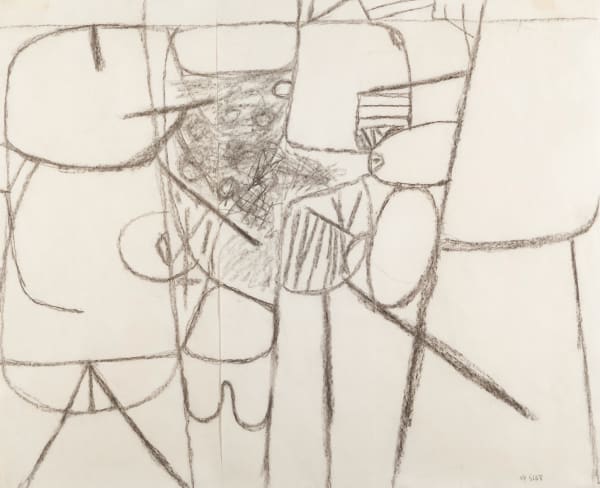William Scott Art for Sale1913-1989
William Scott was one of the most influential painters in post-war Britain, celebrated for a distinctive balance between abstraction and the everyday. Born in Greenock, Scotland, and raised in Northern Ireland, he trained at the Royal Academy Schools in London before the Second World War interrupted his career. His early work explored still-life and landscape, but by the late 1940s, he had developed the pared-back compositions for which he is best known.
Scott’s paintings bridge the language of European Modernism and a distinctly British sensibility. His reduced palette and subtle interplay of form and colour created a visual rhythm that earned him international recognition. He exhibited widely, representing Britain at the Venice Biennale in 1958, and his work is held in major collections including the Tate, MoMA New York, and the Art Institute of Chicago.
Today, Scott’s paintings are regarded as cornerstones of modern British abstraction. Collectors admire his ability to distil domestic motifs – the table, the pan, the vessel – into pure meditations on space and form. With strong museum representation and a lasting critical reputation, his work remains highly sought-after on both sides of the Atlantic, appealing to those building collections of significant post-war British art.
-
 William ScottStill Life with Bowl and Olives, 1950
William ScottStill Life with Bowl and Olives, 1950 -
 William ScottBlue and Black Painting, 1959
William ScottBlue and Black Painting, 1959 -
 William ScottStrong Note Orange, 1972
William ScottStrong Note Orange, 1972 -
 William ScottUntitled (White Painting), 1961
William ScottUntitled (White Painting), 1961 -
 William ScottStill Life, Beans, 1976
William ScottStill Life, Beans, 1976 -
 William Scott(Abstract Painting), 1959
William Scott(Abstract Painting), 1959 -
 William ScottUntitled, 1965
William ScottUntitled, 1965 -
 William ScottUntitled, 1963
William ScottUntitled, 1963 -
 William ScottWhites, 1960
William ScottWhites, 1960 -
 William ScottUntitled, 1964
William ScottUntitled, 1964 -
 William ScottOriginal Gouache for Grapes, 1979
William ScottOriginal Gouache for Grapes, 1979 -
 William ScottBlue, Black and White, 1972
William ScottBlue, Black and White, 1972 -
 William ScottOriginal Gouache for Odeon Suite II, 1966
William ScottOriginal Gouache for Odeon Suite II, 1966 -
 William ScottEggs in Blue Pan, circa 1957
William ScottEggs in Blue Pan, circa 1957 -
 William ScottDivided Blues, 1965, circa
William ScottDivided Blues, 1965, circa -
 William ScottRed with Wrath, 1965, circa
William ScottRed with Wrath, 1965, circa -
 William ScottBlue and White, 1965, circa
William ScottBlue and White, 1965, circa -
 William ScottGouache Blue and Black, 1962/63, circa
William ScottGouache Blue and Black, 1962/63, circa -
 William ScottBlue and White Collage (Altnagelvin), 1959, circa
William ScottBlue and White Collage (Altnagelvin), 1959, circa -
 William ScottDarker Blues, 1965, circa
William ScottDarker Blues, 1965, circa -
 William ScottAbstract Composition, 1959-1960, circa
William ScottAbstract Composition, 1959-1960, circa -
 William ScottBusby, from the Coronation Series, 1953
William ScottBusby, from the Coronation Series, 1953 -
 William ScottThe Bird Cage, No.14, 1947
William ScottThe Bird Cage, No.14, 1947 -
 William ScottScalpay, from Europäische Graphik I, 1963£ 4,250.00
William ScottScalpay, from Europäische Graphik I, 1963£ 4,250.00 -
 William ScottSkara Brae, 1959£ 3,250.00
William ScottSkara Brae, 1959£ 3,250.00 -
 William ScottSkara Brae, 1959£ 3,250.00
William ScottSkara Brae, 1959£ 3,250.00
William Scott was a British artist, best known for his still life and abstract painting.
William Scott was born in Greenock, Scotland to Irish and Scottish parents, moving to Ulster when Scott was 11 years old where he spent the remainder of his early life. Scott studied first at Belfast College of Art (1928-1931) and later at the Royal Academy (1931-1935), where he shared accommodation with the poet Dylan Thomas. After completing his studies, Scott lived in France for several years, mainly in Port Avon and St Tropez, developing a life-long kinship with French still life painting. Jean-Baptiste-Siméon Chardin was particularly interesting to the artist during this period, later he would become more influenced by Georges Braque. Alongside French still life painting, Scott drew inspiration from pre-historic art and the untrained art of children.
The artist spent his adult life living in both London and Somerset, he was also a frequent visitor to the Cornwall where he connected with artists of the St Ives school and was particularly fond of the fishing village of Mousehole, which is depicted in his work. In 1953, Scott traveled to New York, becoming one of the first British artists to meet the Abstract Expressionists, including Jackson Pollock and Willem de Kooning. Mark Rothko would later visit the the Scotts in Somerset. The recipient of numerous awards throughout his career, including the Painters Prize at the John Moore’s Liverpool Exhibition (1959), Scott also represented Britain at the 1958 Venice Biennale.
Scott produced some landscapes and nudes but painted still life work for his entire career, he experimented with abstraction during the 1950s but these were always based within the tradition of still life. His work often bridged the gap between representation and abstraction, with motifs of objects such as cups, saucepans and frying baskets, still recognisable even in his later, more austere work, along with the flat planes of colour that often characterise his work. The artist compared his repeated depictions of kitchen objects to that of Braque’s frequent studies of guitars, 'if the guitar was to Braque his Madonna the frying pan could be my guitar’. While the subject matter remained much the same throughout Scott’s career, elements such as scale developed with his compositions becoming larger and the surface of the painting more laboured and worked.
Public collections representing Scott’s work include Tate Gallery which held retrospectives of his work in 1972 and 2013, Fitzwilliam Museum, Jerwood Foundation and the Guggenheim Museum, New York. His work was formally part of the private art collection of David Bowie. Scott’s early life was made into a film, ‘Every Picture Tells a Story’ by his artist and director son, James Scott.



























